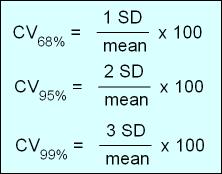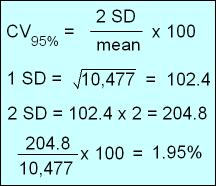- Usually used in the laboratory to determine if the CV is within a certain standard deviation (SD)
- Pipette precision - taking several pipette readings and determining the variation within the values taken
- Intra-assay precision - is applied when control samples are placed at regular intervals within a long assay
- Inter-assay precision - the same control sample is run each time an assay is completed
- CV can also be used to determine the % error if you know the mean and it's SD
- Calculating CV with 1, 2 or 3 SDs (68%, 95%, or 99%)
- The greater the SD value the less precise the data because it increases the acceptable range within the deviation
What is an assay? When assaying laboratory samples (ex. Determination of TSH) controls, with known values, are placed long with the unknown patient data. if the control falls to meet an expected range, then the patient samples will be considered as having inaccurate values. Controls should all be within a certain percentage. An intra-assay value of < 5% is expected. For inter-assay this value should < 10%

- At issue is a decision to decide on how much SD to apply to the calculation
- Do you want 68%, 95%, or 99%?
- The greater the SD the higher the level of confidence or confidence interval, but the less precise you will be
- Given a specific example, if the value you have falls within the CV acceptable limits then you are confident that the value samples being analyzed is precise and acceptable

- As an example let us say that a series of 137Cs counts are analyzed over a ten day period (QC on your well counter) and the mean value is 10,477. Applying 95% level of confidence determine if this value of variation is acceptable
- From the above calculation, if the accepted % deviation is 5% or less then the evaluation passes. For a 5% (95% SD) the above is applied and your variation or CV is 1.95%. Since this value is below 5% the procedure passes its test. But what does this mean?
- What happens to the CV if 3SD and your goal is still 5%? What if your goal is 1% at SDs?
- If the SD is 217 and the mean is 8,975 counts, what is the CV?
- What is the % error if the mean is 47.6 mL and it has an SD of 0.21?